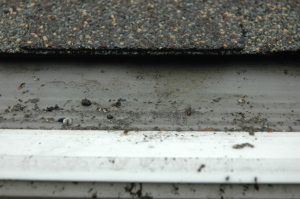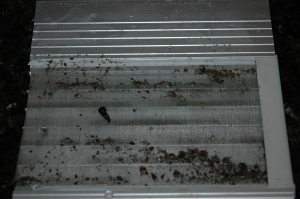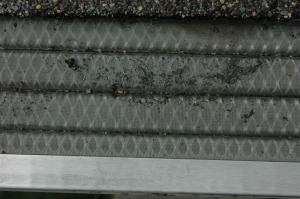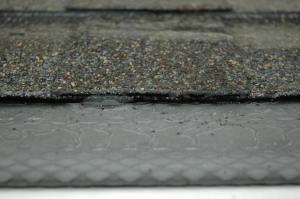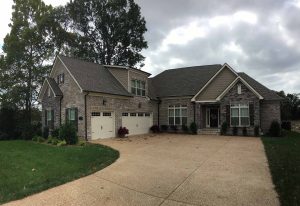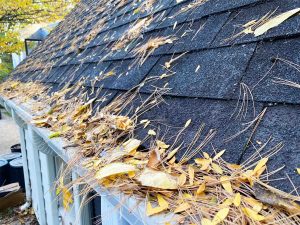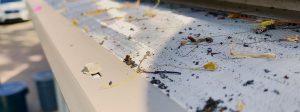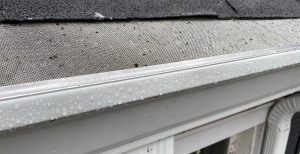Over the past several months, I have been putting microscreen gutter guards through a basic test to see how much water they can handle and how they handle debris — small debris. The gutter guards were subjected to everything from light rain to torrential downpours.
On one occasion, we had a rainstorm that dropped 3″ – 8″ of rainfall in several hours, with approximately 4″ rain in our test area. It’s fair to say that this was a good test environment to observe how these products handled water flow and small debris.
Here’s the scenario:
- Gutter guards were placed below a downspout that feeds from an upper-roof onto a first floor roof surface with asphalt shingles. This is the sole downspout for a roof section that is approximately 300 square feet. The building on which the guards were tested is 3-stories. The downspout feeds from the 3rd story to a roof on the first story, so the flow rate is quite strong during a heavy rain.
- I tested four microscreen gutter guards and three solid surface (reverse curve) gutter guards that were interchanged in the area below the downspout opening. The micro screen gutter guards included LeafFilter, GutterGlove, Leaf Solution, and DiamondBack gutter covers. I compared these to solid surface (reverse curve) gutter guards from LeaFree (note one “f” not two), Elko GuttaPro and the solid vinyl gutter cover (formerly known as Cinch) available at Home Depot and Lowe’s.
- My interest was to learn how much water the gutter guards could handle and if there was a dramatic performance difference between the brands.
- I also wanted to see how they handled shingle granules. Why shingle granules? Primarily because granules are small and naturally separate from shingles. When shingle granules enter the gutters, they can impede the flow of water and any debris that flows into the gutter, ultimately causing clogs. Most homeowners don’t even think about shingle granules (aka “shingle grit”) as being an issue, but it is.
- For this test, I didn’t care about leaves and larger debris. I’ll do future testing in a more conducive environment.
Here are my observations:
The granddaddy of microscreen gutter guards, LeafFilter features a PVC base with surgical grade stainless steel micro-screen insert. LeafFilter fits directly in the gutter as opposed to sliding under or sitting on top of the shingles. The product rests on top of the hidden hangers in the gutters.
The concept is that since it is independent of the shingles, it’s not impacted if you decide to change your roof shingles in the future. It has a built-in slope to help coax debris off of its surface. The screen is 50-microns, which translates to approximately 8,100 holes per square inch. This is small enough to keep all debris — including shingle granules — out of your gutters.
LeafFilter handles water very well and, like the other micro screen gutter guards, it will handle considerably more water than solid surface gutter guards. In one of my tests, there was an upper-limit as to how much water it would handle, but the odds of you experiencing that amount of water during a typical storm is very unlikely.
Coupled with the fact that the water flow was amplified many times since it was below a downspout carrying water off of 300 sq. ft. surface area — the manufacturer would recommend a more open screen for this area — you’ll be pleased with LeafFilter’s ability to absorb most water in most conditions.
On the design front, shingle granules don’t stand a chance of penetrating your gutters. A bead of caulk holds the screen into place at the top and bottom edge of the screen. This keeps the screen firmly in place and it also can help to act as a barrier to slow water at the bottom edge of the screen. Most shingle granules will wash off or be blown off the screen.
GutterGlove is the sturdiest gutter cover I tested and on the market, I suspect. GutterGlove, like LeafFilter, uses a micro screen of approximately 50 microns. It is made of rigid, heavy gauge aluminum with a stainless steel screen. The screen is attached at the top and bottom edges with a factory-applied bead of caulk. Gutter Glove slides under the first course of shingles.
The angle of the gutter guard is dependent on the roof pitch. In our tests, its angle was probably 1-2 degrees steeper pitch than LeafFilter and virtually identical to Leaf Solution.
While the test conditions for Gutter Glove were not as rigorous — it didn’t rain as hard while testing this product — I have no doubt that it will handle a comparable amount of water to LeafFilter and Leaf Solution gutter covers.
What I found interesting, however, was that the screen is recessed approximately 1/8″ below the upper and lower edges of the guard’s frame. This creates a bit of a debris trap for small particles such as shingle granules.
During my tests, the granules shifted around the screen, and after one strong thunderstorm, some of the granules and other small debris had washed off the screen, but more debris remained on Gutter Glove than I would have anticipated.
While most small debris would have a chance of washing or blowing off LeafFilter, it’s more likely that one would have to hose off or sweep debris off GutterGlove based on its design. With that said, lingering shingle granules and pollen likely will not affect Gutter Glove’s performance over time.
An interesting design, Leaf Solution is made of a lighter grade aluminum — similar to gutters — with a stainless steel micro screen, and it slides under the first course of shingles. Leaf Solution uses a 50-micron screen and, unlike LeafFilter and GutterGlove, the screen and frame are integrated together so that no caulk is required to hold the screen in place.
This provides the smoothest transition at the top and bottom edge of the screen. Leaf Solution throws in a few more design features with three “dips” within the screen to help slow water flow across the surface.
While it’s an interesting idea, this design feature didn’t appear to offer any additional water handling capabilities in my tests, and it acts more as a debris trap than anything.
Because of inconsistencies in the manufacturing process, the dips tend to have a bit more of a gap than the design likely called for, and it became an instant haven for shingle granules and other small debris.
While you may not see this from street level, granules will fill the gaps; however, I didn’t see any evidence that this would impact Leaf Solution’s performance. On the other hand, if the gaps were supposed to add rigidity to the guard, it doesn’t work.
Leaf Solution is the flimsiest of the micro screen guards tested. My primary concern is that if a falling branch lands on a section, it could easily damage or deform it, and it would have to be replaced.
DiamondBack gutter guards are offered in many styles. I have tested a few, but for the purpose of this comparison, I selected the pine needle screen which is made of a stainless steel micro-screen. Not as tightly woven as LeafFilter, GutterGlove and Leaf Solution, it is still more than adequate to keep shingle granules out of your gutters.
- The fact that the screen is more open, it theoretically can handle more water than the other micro-screen products; however, the screen is wrapped around an open expanded metal frame, and this causes water to spill over the guards during heavy rains.
- Whereas the other products have closed PVC or aluminum frames, DiamondBack doesn’t offer the same level of protection so water has a tendency to pass through the openings towards the gutter lip.
DiamondBack rests in the gutter and sits on hidden hangers or the older spike and ferrule system. From a design perspective, it’s relatively easy to install. Simply squeeze the back and front of the metal base and lock it into position.
The bad news is that this creates an arc in the middle of the screen with both a forward AND backward slope. This is an issue if your shingles do not encroach into the gutters.
If the shingles do overlap into the gutters, then the shingles will cover up most of the backwards slope. If not, then this wouldn’t be a good option because debris would get trapped between your roof edge and the guards.
The manufacturer does offer an alternative installation method which addresses this issue. Because of its expanded metal frame, DiamondBack is a very solid product, yet it is relatively easy to work with.
Another concern is that the metal base has a tendency to rust when chipped or cut, and these rust spots can transfer to the stainless steel screen. I’m not sure how this will impact the product (it has a 20-year warranty) or it’s appearance over time, but it’s worth noting that the manufacturer suggests that installers use spray paint to cover any exposed metal areas during installation!
Results
The water handling capabilities of LeafFilter, GutterGlove and Leaf Solution were virtually identical. The common denominator was that each screen offered a very similar looking 50-micron screen (8,100 holes per square inch).
Due to DiamondBack’s open design — all screen with no frame at the top or bottom — caused more water to spill over the gutters during heavy rain. This spillover was in the form of water dripping off the bottom of the gutter, and the amount of water varied based on the intensity of the rainfall.
The other tested factor was how well the gutter guards shed shingle granules. In this case, the nod goes to LeafFilter primarily because the screen sits flat against the base and the lip over which the granules need to roll off offers little resistance.
On our gutters, DiamondBack performed similarly to LeafFilter since the shingles covered the back arc of the guard. The shingles provided enough coverage to allow for a forward slope towards the gutter’s edge; however, if you don’t have the benefit of shingles or a metal roof overlapping into the gutter, DiamondBack may prove to trap more debris between the roof edge and gutter than any of the tested products.
Gutter Glove’s relatively high framework kept granules from easily rolling off the screen surface. Leaf Solution held the most granules on the screen surface because its three-dip design acts as much as a trap for the granules as it does a speed bump for water.


